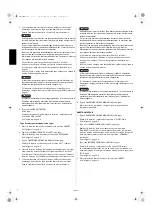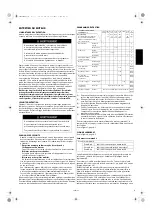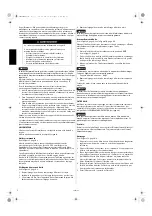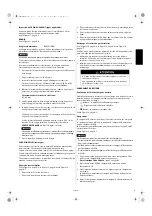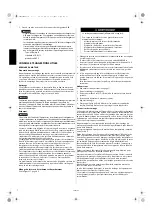
ENGLISH
4
SERVICING YOUR ENGINE
THE IMPORTANCE OF MAINTENANCE
Good maintenance is essential for safe, economical and trouble-free
operation. It will also help reduce pollution.
To help you properly care for your engine, the following pages include a
maintenance schedule, routine inspection procedures, and simple
maintenance procedures using basic hand tools. Other service tasks that
are more difficult, or require special tools, are best handled by
professionals and are normally performed by a Honda technician or other
qualified mechanic.
The maintenance schedule applies to normal operating conditions. If you
operate your engine under severe conditions, such as sustained high-
load or high-temperature operation, or use in unusually wet or dusty
conditions, consult your Honda servicing dealer for recommendations
applicable to your individual needs and use.
Use only Honda Genuine parts or their equivalent. The use of
replacement parts which are not of equivalent quality may damage
the engine.
Maintenance, replacement, or repair of the emission control devices
and systems may be performed by any engine repair establishment
or individual, using parts that are ‘‘certified’’ to EPA standards.
MAINTENANCE SAFETY
Some of the most important safety precautions follow. However, we
cannot warn you of every conceivable hazard that can arise in
performing maintenance. Only you can decide whether or not you
should perform a given task.
SAFETY PRECAUTIONS
• Make sure the engine is off before you begin any maintenance or
repairs. To prevent unintentional startup, disconnect the spark plug
cap. This will eliminate several potential hazards:
–
Carbon monoxide poisoning from engine exhaust.
Operate outside, away from open windows or doors.
–
Burns from hot parts.
Let the engine and exhaust system cool before touching.
–
Injury from moving parts.
Do not run the engine unless instructed to do so.
• Read the instructions before you begin, and make sure you have the
tools and skills required.
• To reduce the possibility of fire or explosion, be careful when working
around gasoline. Use only a non-flammable solvent, not gasoline, to
clean parts. Keep cigarettes, sparks and flames away from all fuel
related parts.
Remember that an authorized Honda servicing dealer knows your engine
best and is fully equipped to maintain and repair it.
To ensure the best quality and reliability, use only new Honda Genuine
parts or their equivalents for repair and replacement.
MAINTENANCE SCHEDULE
(1)
For commercial use, log hours of operation to determine proper
maintenance intervals.
(2)
Change engine oil every 25 hours when used heavy load or in high
ambient temperature.
(3)
Service more frequently when used in dusty areas.
(4)
These items should be serviced by your servicing dealer, unless you
have the proper tools and are mechanically proficient. Refer to
Honda shop manual for service procedures.
(5)
In Europe and other countries where the machinery directive 2006/
42/EC is enforced, this cleaning should be done by your servicing
dealer.
To perform maintenance on the lower part of the engine (Machine), turn
it 90° and lay it down with the carburetor/air cleaner always at the top.
See Figure 7, page A-3.
REFUELING
See Figure 6, page A-3.
Recommended Fuel
Fuel specification(s) necessary to maintain the performance of the
emissions control system: E10 fuel referenced in EU regulation.
This engine is certified to operate on unleaded gasoline with a
research octane rating of 91 or higher (a pump octane rating of 86 or
higher).
Refuel in a well ventilated area with the engine stopped. If the
engine has been running, allow it to cool first. Never refuel the
engine inside a building where gasoline fumes may reach flames or
sparks.
You may use unleaded gasoline containing no more than 10%
ethanol (E10) or 5% methanol by volume. In addition, methanol
must contain cosolvents and corrosion inhibitors. Use of fuels with
content of ethanol or methanol greater than shown above may
cause starting and/or performance problems. It may also damage
metal, rubber, and plastic parts of the fuel system. Engine damage
Failure to properly maintain this engine, or failing to
correct a problem before operation, could result in a
significant malfunction.
Some malfunctions can cause serious injuries or death.
Always follow the inspection and maintenance
recommendations and schedules in this owner’s manual.
Improper maintenance can cause an unsafe condition.
Failure to properly follow maintenance instructions and
precautions can cause serious injuries or death.
Always follow the procedures and precautions in this
owner’s manual.
Each
use
First
month
or
5 hrs.
Every
3
months
or
25 hrs.
Every
6
months
or
50 hrs.
Every
year
or
100 hrs.
150 hrs. Every
2 year
or
250 hrs.
Refer
to
Page
Engine oil
Check level
o
Change
o
o (2)
Air cleaner
Check
o
Clean
o (3)
Replace
o
Flywheel brake pad
(applicable types)
Check
o
Spark plug
Check-adjust
o
Replace
o
Spark arrester
(applicable types)
Clean
o (5)
Shop
manual
Idle speed
Check
o (4)
Shop
manual
Fuel tank and filter
Clean
o (4)
Shop
manual
Valve clearance
Check-adjust
o (4)
Shop
manual
Combustion
chamber
Clean
After every 250 hrs. (4)
Shop
manual
Fuel tube
Check
Every 2 years (Replace if necessary) (4)
Shop
manual
Unleaded gasoline
U.S.
Pump octane rating 86 or higher
Except U.S.
Research octane rating 91 or higher
Pump octane rating 86 or higher
REGULAR SERVICE PERIOD (1)
Perform at every indicated
month or operating hours
interval, whichever comes
first.
ITEM
3RZ9S8000.book 4 ページ 2019年9月3日 火曜日 午後4時17分




















